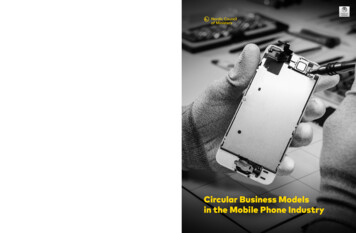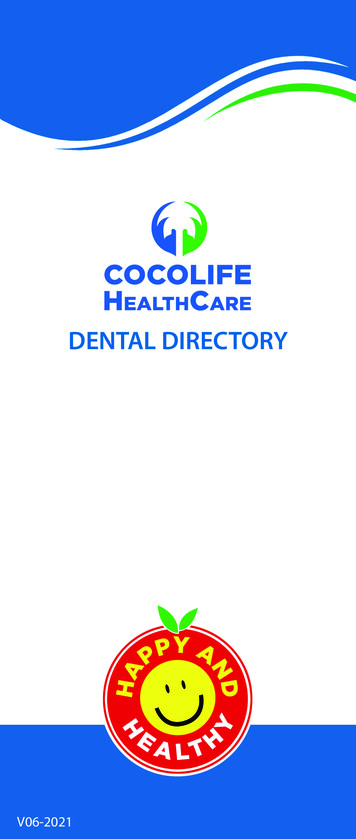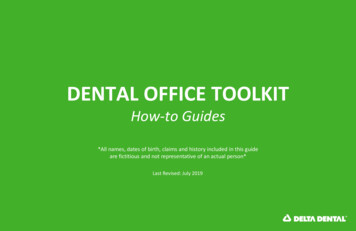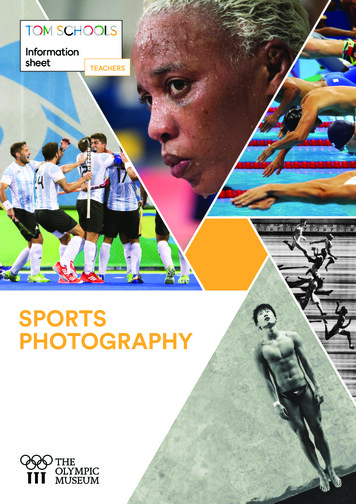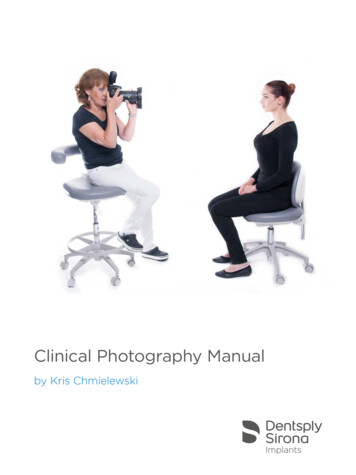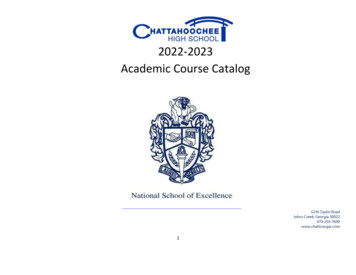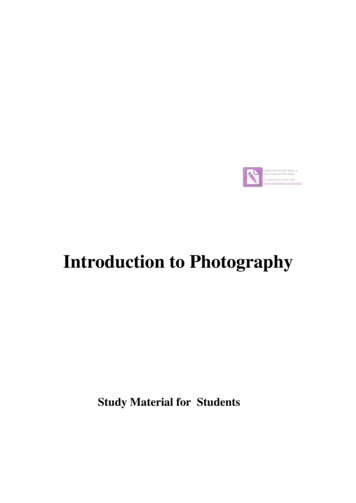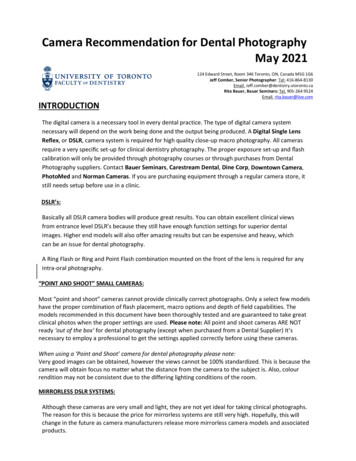
Transcription
Camera Recommendation for Dental PhotographyMay 2021INTRODUCTION124 Edward Street, Room 346 Toronto, ON, Canada M5G 1G6Jeff Comber, Senior Photographer: Tel: 416-864-8130Email. Jeff.comber@dentistry.utoronto.caRita Bauer, Bauer Seminars: Tel. 905-264 9524Email. rita.bauer@live.comThe digital camera is a necessary tool in every dental practice. The type of digital camera systemnecessary will depend on the work being done and the output being produced. A Digital Single LensReflex, or DSLR, camera system is required for high quality close-up macro photography. All camerasrequire a very specific set-up for clinical dentistry photography. The proper exposure set-up and flashcalibration will only be provided through photography courses or through purchases from DentalPhotography suppliers. Contact Bauer Seminars, Carestream Dental, Dine Corp, Downtown Camera,PhotoMed and Norman Cameras. If you are purchasing equipment through a regular camera store, itstill needs setup before use in a clinic.DSLR’s:Basically all DSLR camera bodies will produce great results. You can obtain excellent clinical viewsfrom entrance level DSLR’s because they still have enough function settings for superior dentalimages. Higher end models will also offer amazing results but can be expensive and heavy, whichcan be an issue for dental photography.A Ring Flash or Ring and Point Flash combination mounted on the front of the lens is required for anyintra-oral photography.“POINT AND SHOOT” SMALL CAMERAS:Most “point and shoot” cameras cannot provide clinically correct photographs. Only a select few modelshave the proper combination of flash placement, macro options and depth of field capabilities. Themodels recommended in this document have been thoroughly tested and are guaranteed to take greatclinical photos when the proper settings are used. Please note: All point and shoot cameras ARE NOTready ‘out of the box’ for dental photography (except when purchased from a Dental Supplier) It’snecessary to employ a professional to get the settings applied correctly before using these cameras.When using a ‘Point and Shoot’ camera for dental photography please note:Very good images can be obtained, however the views cannot be 100% standardized. This is because thecamera will obtain focus no matter what the distance from the camera to the subject is. Also, colourrendition may not be consistent due to the differing lighting conditions of the room.MIRRORLESS DSLR SYSTEMS:Although these cameras are very small and light, they are not yet ideal for taking clinical photographs.The reason for this is because the price for mirrorless systems are still very high. Hopefully, this willchange in the future as camera manufacturers release more mirrorless camera models and associatedproducts.
SMARTPHONE PHOTOGRAPHY:Using a smartphone to document your patients IS NOT RECOMMENDED. Up to this point, there is nostandardized and secure way to take well-lit, clinically correct photographs. There are many differentfactors for this: Many different smartphone manufacturers and models with differing lenses andtelephoto/focusing limitations. A wide array of necessary additional lighting equipment that may, or maynot work for intra-oral photography. The extreme awkwardness of trying to take a photograph with onehand using a phone. In addition, there is the fact that sensitive patient information is now on a devicethat can be easily lost, stolen or hacked.DSLR LENSES:The lens required is dependent on the views necessary: 90mm, 100mm or 105mm macro lens extreme close-up, up to 2 teeth85mm macro lens up to a quadrant60mm macro lens no smaller than a full mouthWhile all these lenses allow you to focus on very small areas, it also means that the working distancebetween the lens and the subject is very short. This means that using lenses with a shorter focallength, can result in the lens and the flash touching the cheek of the patient, if you try to get anextreme close up view.Restorative Dentists, Cosmetic Dentists, Prosthodontists and Periodontists, require a lens with alonger focal length, because of the extreme close up views, and definition that must bedocumented for this type of lens. Orthodontists could use a 60mm macro lens, because theytypically document only the full mouth.CANON CAMERA BODY RECOMMENDATIONS:The Canon EOS 850D (Rebel T8i), Canon EOS T100 and Canon EOS 250D (Rebel SL3) are the first choice asa DSLR system. They are a substantially smaller, lighter and less expensive SLR camera compared to other modelsand offer easy exposure calibration and consistent results.Please see the following Canon camera bodies that are also recommended. However, they can be hard tofind as they are now discontinued. They are: Canon Rebel series T6, T5, SL1, T5i and T6s.(Please note: The grip on some Rebel models (such as the T5i) are smaller and can be hard to hold if youhave large hands however, any upgrades to a higher end model will add a significant amount of weight tothe system so it’s important to find out what works best for you.)
CANON LENS RECOMMENDATIONS:1. Canon EF 100mm f/2.8 Macro USM Macro lens (DISCONTINUED)Please note: You do NOT need the Canon EF 100mm F2.8 “L IS” USMMacro lens with the VR function which costs over US 1000. Vibrationreduction is only required if you take photographs in low light andwithout flash. This model is also heavier than the earlier model USMMacro lens.2. Canon EF-S 60mm f/2.8 Macro USM Lens - Less expensive and lighter than the 100mm macrolens, however this lens will only work well for close ups no closer than a full mouth view. Closestrecommended view is only the full mouth due to the short working distance. The flash will touch thepatient’s cheek if close ups of posterior teeth are required. This short working distance will result inslightly barrel shaped, distorted images on both facial and intra oral views.CANON FLASH SYSTEM RECOMMENDATIONS:Canon Ring Lite MR 14EX II or the previous model, Canon Ring LiteMR-14EX – These Canon flash systems are totally integrated and are, inmy opinion, the easiest system to calibrate and standardize for dentalphotography. Don’t try to save money by purchasing a cheap ring flashor ring light. They are very difficult to calibrate, and quite often, it isimpossible to get consistent exposures with a sufficient depth of field.Canon Macro Twin Lite MT-26EX-RT – This adjustable twopoint flash system from Canon is a reliable and versatile flash.The flash points can be adjusted to control the direction andquality of light to produce dynamic images. However, thiscustomization can also lead to inconsistency and clumsiness(especially if this piece of equipment is shared between manystaff members). This flash is also heavier and more expensive than the MR-14EXTHIRD PARTY FLASH SYSTEMS FOR CANON:Yongnuo YN-14EX-C– These Ring Lite units look similar to the Canon Ring Lite but are about one quarterof the cost. However, the build quality is poor and the light output tends to be inconsistent resulting inover/under exposed images. These flaws can really show down your workflow. The money saved on thisitem needs to be weighed against the additional time and aggravation needed to get the right shot.
NIKON CAMERA BODY RECOMMENDATIONS:Currently the best choices are the Nikon D3500 and the D5600. These are the recommended bodiesbecause of the reasonable price. The following discontinued models are also great options if they can befound: D3400, D5500, D5300, and the D3300(Please note: Nikon no longer manufactures its own Ringlight. Read on for lighting alternatives)NIKON LENS RECOMMENDATIONS:1. Nikon 85 mm macro lens - very light but is not capable of achieving extreme close-ups.2. Nikon 105mm macro lens – versatile lens made with excellent quality, but is heavy.THIRD PARTY LENS ALTERNATIVES:The Tamron 90mm or Sigma 105mm macro lens are some alternatives that could be considered. Theyare available for both the Canon and Nikon systems and typically are less expensive than the Canon andNikon lenses.Please note: any 60mm macro lenses should be used with CAUTION. The short working distance willresult in a distorted “barrel shaped” image if used too close to the subject. Closest recommendedview is no smaller than a full mouth, due to the short working distance.Please note: the 18-55mm lens (that often comes with a purchase of a camera body kit) should NOTBE USED. While this lens is ok for hobby photography, it is not appropriate for dental photography.Even when this lens is set to 55 mm the short working distance results in barrel shaped distortion forboth the facial and the intra oral views.FLASH SYSTEMS FOR NIKON CAMERAS:Nikon has discontinued their ring flash and replaced itwith the Nikon R1 macro flash. This unit has twoadjustable flash points, which are attached to the front ofthe lens. This product can provide great results however;the downside of this system is that the positioning of theflashes requires attention to detail to get greatphotographs. The flash placement and direction is keywhen trying to remove unwanted shadows. Thisbecomes cumbersome when used by a dental team in afast-paced practice.
THIRD PARTY FLASH SYSTEMS:Dine- Mini Ring and Point Flash for Nikon or Canon www.dinecorp.com Thering flash produces well lit intra-oral images and the point flash is able tocontrol the location of the shadows for extra-oral views. The instructions aresupplied by Dine Corporation and the technical support system is excellent.The Sigma EM-140 DG Macro Ring Flash works well with recent camera models,but it is very difficult to calibrate the exposure settings when used with oldermodel cameras.Metz Mecablitz 15 MS-1 wireless macro flash – This item has beendiscontinued, but if found, is a decent option. However, achieving aconsistent colour correction proves to be difficult. It also requires anextensive exposure calibration, as the images appear very flat.A WARNING REGARDING LOW QUALITY RING FLASHES AND LED RING LIGHTS:Low cost ring flashes (such as the Bower macro ring flash) and LED ring lights (such as the Amaran HaloLED light or the Polaroid LED ring flash) cannot be used for dental photography when used with a DSLRcamera system. The light output is not powerful enough to properly expose images (taken at f-32 or f-22)for maximum depth of field, thus ensuring sharp focus for all teeth in the intra-oral image.
MIRRORLESS DSLRS:As mentioned earlier in this document, mirrorless cameras are still too expensive for us to fully endorse.Mirrorless systems are marginally lighter compared to a DSLR system, but other typical selling points of amirrorless system (ie: silent shutter, extremely high-quality video recording) won’t improve your clinicalphotographs. However, other features like a bright electronic viewfinder and ‘focus peaking’ can be usefulfeatures. In the end, mirrorless camera systems are clearly the direction that the industry is going in. Pleasesee some currently recommended mirrorless camera equipment below:When it comes to the Canon mirrorless systems, it stands out as the top mirrorless option going forward.Canon, in addition to it’s ring flash, has invested in the production of macro lenses that are designed foruse with their mirrorless bodies. These lenses are the RF series lenses. Currently, the Macro RF lensoptions are: Canon RF 100mm F2.8L Macro IS USM (Approx retail price: 1850 CAD) Canon RF 85mm F2 Macro (Approx retail price: 850 CAD)Its important to note, that Canons older EF lenses are compatible with their mirrorless camera bodies,however an EF-EOS R Mount Adapter must be used. The cost of this adapter is Approx: 200 CAD.When it comes to a Canon mirrorless camera body there are currently two options to consider at thistime:The Canon M50 Mark 2 has a smaller camera body with a cropped sensor.The price tag (Approx: 950 CAD) is attractive but the problem with thiscamera is the small grip. With the combination of a large macro lens andring flash attached to the end of the camera it makes this setup very‘front heavy’ and very easy to drop.The Canon R6 is the other option, and its notable that this camera has afull frame sensor. At Approx: 3500 CAD this is a very expensive optionbut it is still the most affordable R series camera body. The build qualityis great and the grip feels secure to hold, even with a heavy macro lensand ring flash.Nikon offers two mirrorless cameras that could be used. They are the Nikon Z50 (Approx: 1100 CAD) andthe Nikon Z5 (Approx: 1800 CAD). No macro Nikon mirrorless lenses are available yet, so an adapterwould have to be purchased to enable the use of the older DX Macro Lenses.Another mirrorless option is the Olympus OM-D E-M10 Mark 3 with the Olympus60mm Macro Lens (which factors out to be about the equivalent of a 120mmmacro lens) and the Olympus Macro Flash STF-8Great results can be obtained with this system. The whole system is substantiallylighter than other options. When it comes to the Flash, close attention must be paid to the position anddirection of the flash points to avoid unwanted shadows. Approx price of this entire setup: 2120 CAD
CURRENT “POINT AND SHOOT” CAMERA RECOMMENDATION:Current recommendation for 2021 – CLINI-CAM(Available from www.downtowncamera.com)The CLINI-CAM is the best small camera on the markettoday. It is light and easy to use, making it perfect fora busy dental practice. This camera comes preprogrammed with two custom settings (Intra-Oral andExtra-Oral) for perfectly exposed images. It is shockproof as well as water-proof, making these cameras very durable and easy to sanitize. The powerful macrolens allows you to capture intra-oral and mirror views as well as great extra-oral images and portraits.Approx retail price: 700 CADDine Digital Solution – Dental CameraDine-Corp released this camera several years ago. It’s similarto the CLINI-CAM, with pre-set dental functions built intothe camera so it’s ready to use right out of the box.However, with a price tag of Approx: 800 USD this is a moreexpensive option.RECOMMENDED DISCONTINUED “POINT AND SHOOT” CAMERAS.The following cameras are no longer available in stores but still might be found on websites like ebay,craigslist or kijiji.These cameras also do not come set-up for dental photography. It is necessary to employ a professional toget the settings applied correctly before using these cameras to take clinical photographs.-Olympus TG 5, TG-4 or TG-3Canon Powershot G16 (Must have a Canon ring flash with adapter ring to achieve shadow freeimages.)Canon Powershot G12 (With the correct exposure and zoom setting this camera will providedistortion free and shadow-less images, without an additional flash system.
Camera Recommendation for Dental Photography. May 2021. 124 Edward Street, Room 346 Toronto, ON, Canada M5G 1G6 . Jeff Comber, Senior Photographer: Tel: 416-864-8130 Email. Jeff.comber@dentistry.utoronto.ca Rita Bauer, Bauer Seminars: Tel. 905-264 9524 Email. rita.bauer@live.com . INTRODUCTION. The digital camera is a necessary tool in every .
